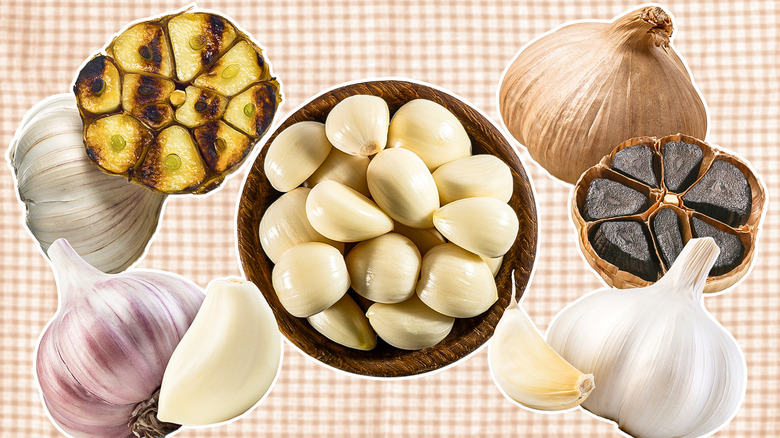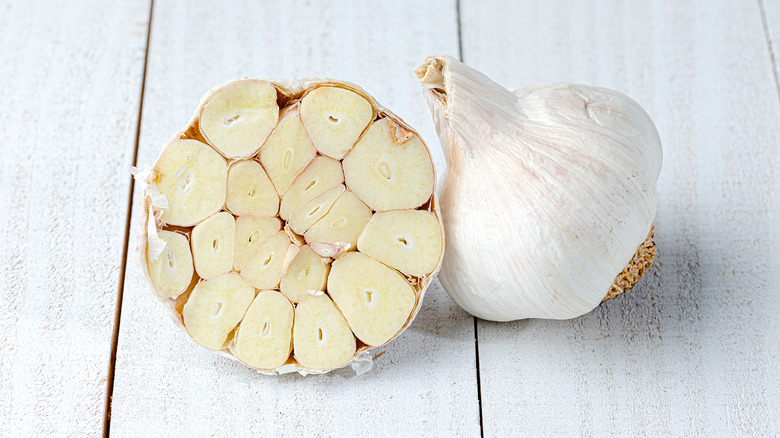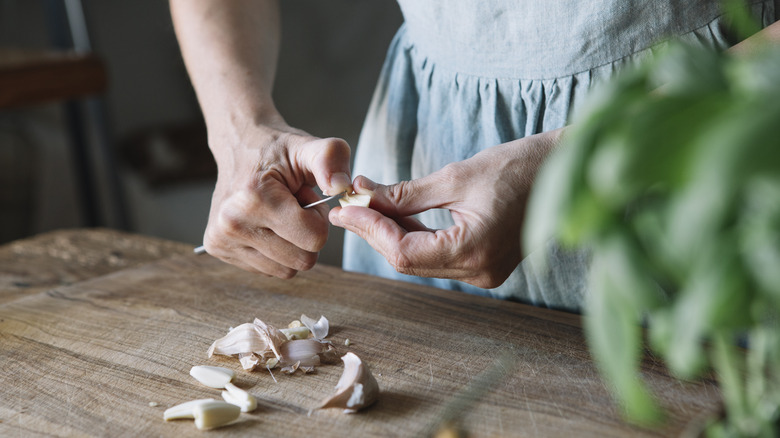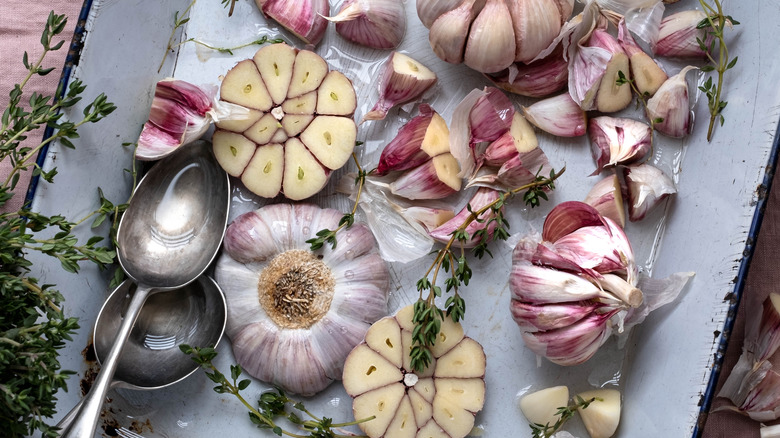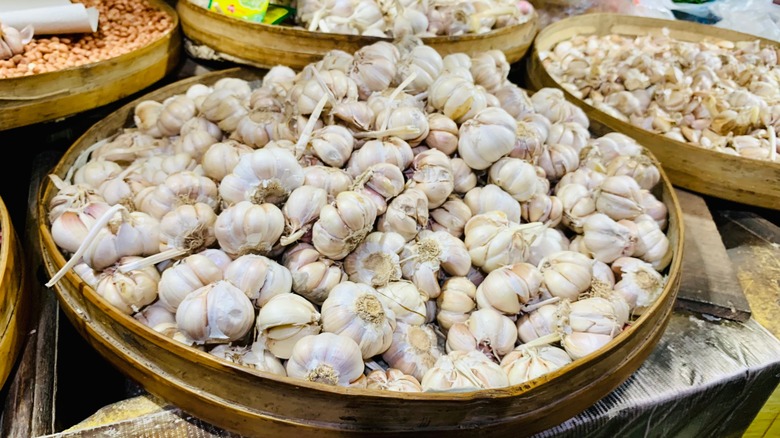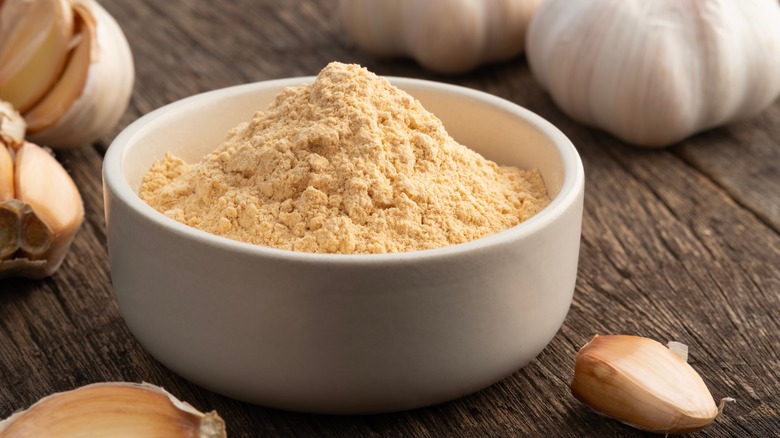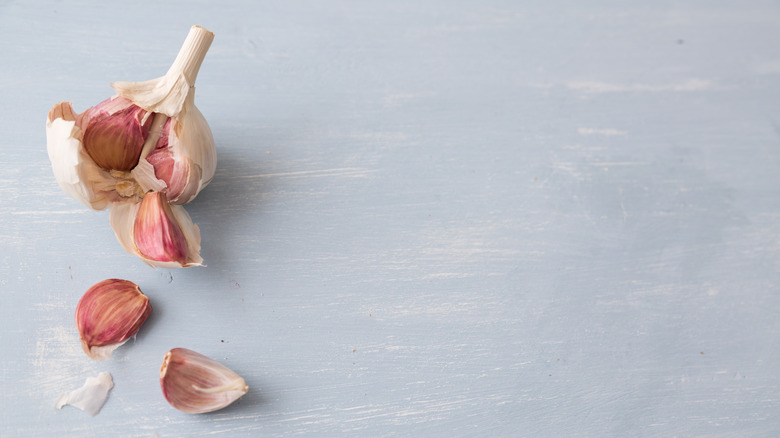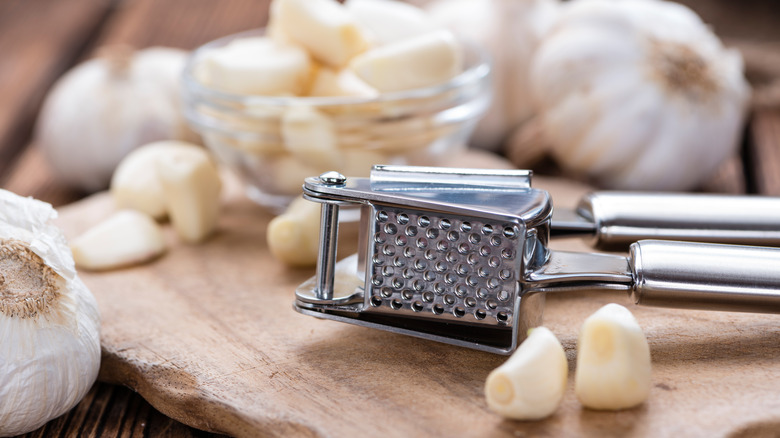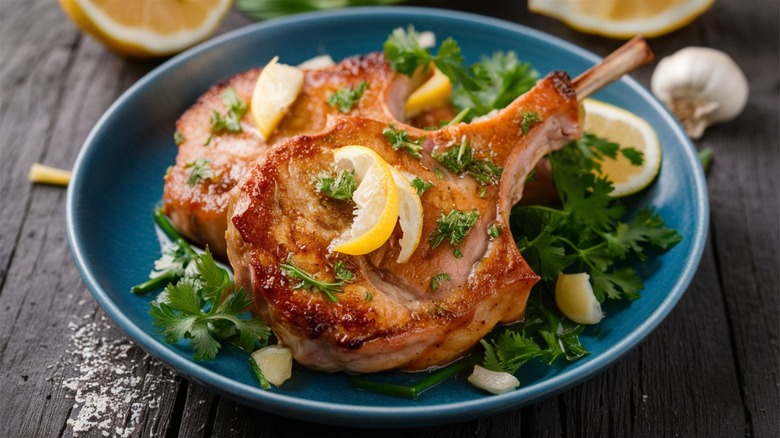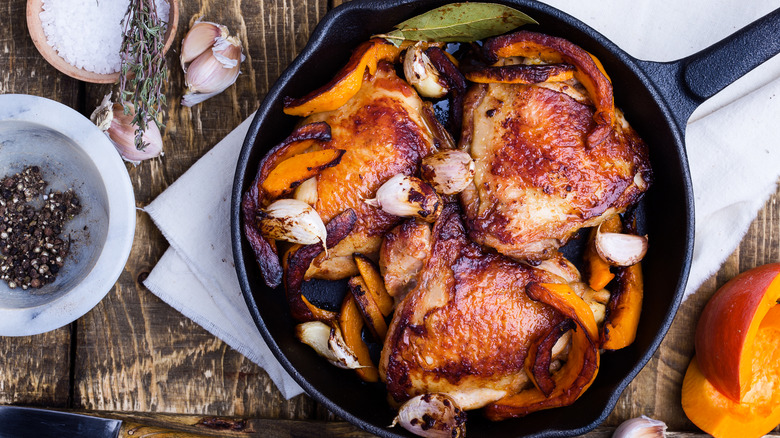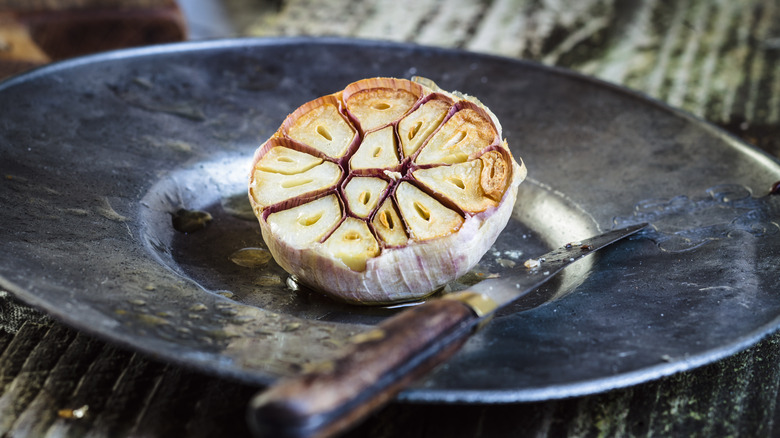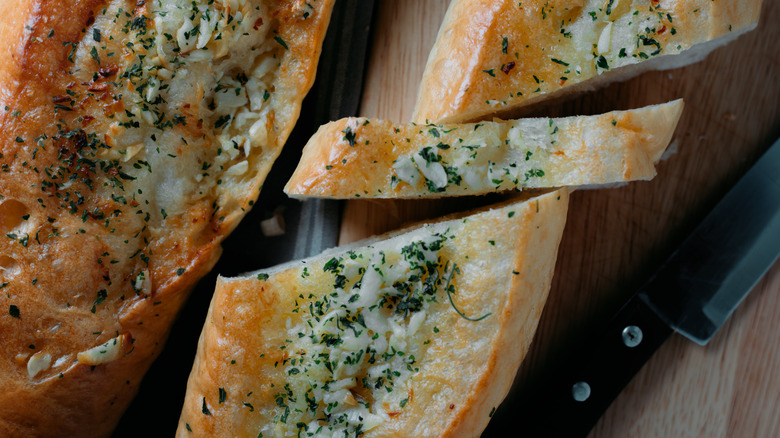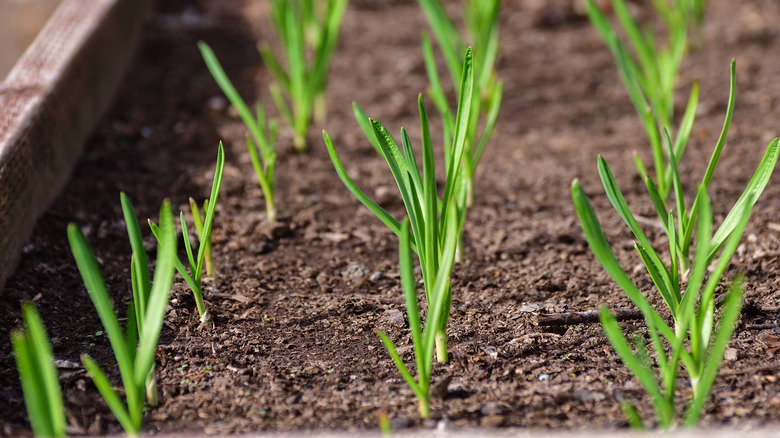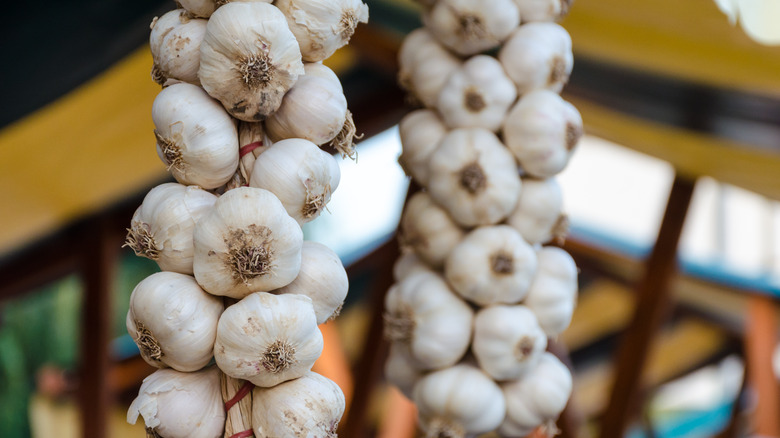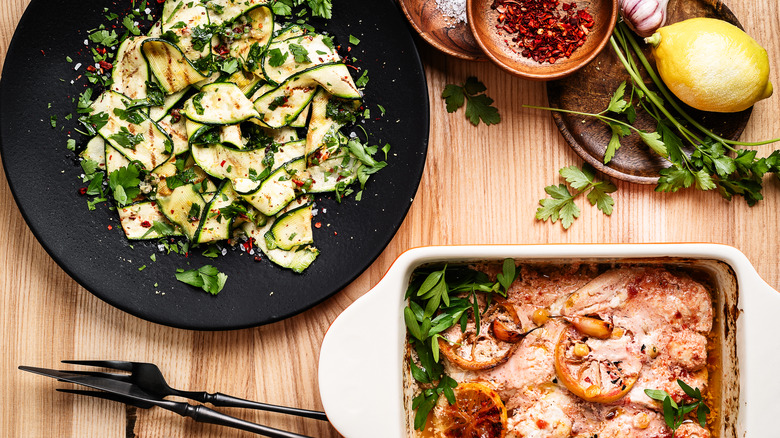The Expert Guide To Cooking With Garlic
Garlic is delicious, but it's also tricky. It can burn easily, make your dishes taste bitter, and misbehave if you prepare it the wrong way (like putting it through a food processor for too long). That's because it has some interesting chemical properties that most home cooks don't understand, but that make cooking with it much easier once you do.
It's not just the science-y stuff that makes garlic an important topic for the home cook, though. Turns out, garlic is often underutilized in the kitchen, or simply pigeonholed to one of a few tasks, when in reality it's such a versatile little root vegetable. As if that's not enough, it has incredible health benefits, such as lowering blood pressure, strengthening the immune system, helping prevent dementia, and even boosting longevity.
The main takeaway: You need to be using more garlic in your kitchen. Because that's easier said than done, Chowhound took a moment to sit down with experts Pinch and Swirl chef Marissa Stevens, Jessica Randhawa, the chef and writer behind The Forked Spoon, and Kevin Ashton, culinary advisor at Restaurantji, to get the skinny on what garlic is good for, how to prepare it, and how to avoid the most common mistakes.
What exactly is garlic?
Garlic (allium sativum) kind of seems like its own thing, but it's actually a member of the amaryllis Amaryllidaceae family, which also includes onions, chives, leeks, shallots, and scallions. It is a bulbous perennial, meaning that what we know as cloves are parts of the garlic's propagation system. If you leave them in the ground rather than harvesting them, each clove can grow into a new garlic bulb, year after year.
Native to the Mediterranean and parts of Asia, garlic's aboveground stems look more like a grass than like a vegetable, growing over the season into a dry, cream-colored stalk with flat green leaves that separate toward the top of the stem. Typically, garlic grows about 2 feet tall and generates about 20 cloves, though this depends on the variety. Garlic is usually propagated by planting cloves, but you can also use seeds.
A brief history of garlic
Let's start with the fun stuff. Many folks hold a number of unsubstantiated beliefs about this humble allium, perhaps the most well-known of which is that garlic can ward off vampires. While vampires aren't real (despite what you've seen on "The X-Files"), there may be some truth to the myth of their aversion to garlic. A group of disorders known as porphyria can reduce the production of hemoglobin, necessary for proper blood function. When this happens, individuals can become sensitive to the sun, their gums can recede and make canines look longer, and their urine can turn dark red, though they do not seek blood (which does not work as a curative). However, garlic may exacerbate these symptoms, leading to the myth.
Now for a more mundane history. Garlic cultivation stretches back 5,000 years, cropping up in Babylon around 2,500 BCE and China at the start of the new age. While today it only grows wild in Kyrgyzstan, Tajikistan, Turkmenistan, and Uzbekistan, it may once have spread from Europe to Africa to the Far East.
Garlic was a well-established seasoning and curative in Ancient Greece, so important that it was placed in temples as offerings to the gods. Garlic came to the Americas with European colonists, but current enthusiasm for it as a seasoning didn't hit today's deific heights until the fall of the Soviet Union, when its native range became accessible to Western countries.
Garlic flavor before and after cooking
Garlic is more of a chimera than many other ingredients, capable of ranging from spicy to sweet, all depending on how it's prepared. "Garlic should have a sharp and pungent taste raw, which mellows and sweetens upon cooking," says Jessica Randhawa. Depending on type and freshness, she continues, it can be mildly spicy to intensely pungent before cooking, becoming mild, soft, and nutty as it caramelizes.
As the chef, you have a lot of control over how this plays out. For instance, says Kevin Ashton, you can get the sharpest and most pungent taste from garlic by crushing it, whether with fine chopping or a garlic press. On the other hand, "The longer it is cooked, the more mellow and subtly sweet it becomes," he notes.
Choosing garlic
Garlic comes in two main varieties: hardneck and softneck plants. The former produce larger cloves but do not last as long, while the latter produce more numerous smaller cloves, with a long shelf life that allows them to be braided into the classic decorative hangings. Hardneck is so named because there is a hard stem in the middle of the clove, whereas softneck garlic has no middle stem and is soft all the way through.
When you grab a clove of garlic off a produce display at the store, chances are it's a softneck bulb that you can slice all the way through the center. Beyond that, there's often no way to tell what variety of garlic you're getting, as there are any number of softneck bulb cultivars. Hardnecks, which are more annoying to use due to the firm inner stem, are nevertheless hardier and easier for northern growers. Some say they are more flavorful, as well. Whatever the case, "When choosing garlic at the store, look for bulbs that are firm with tight, unbroken skins," Jessica Randhawa says. "Avoid any with visible mold or soft spots."
If you ever see elephant garlic at the store or farmers market, take note: It's not really garlic. Although it looks like a garlic bulb, only twice the size, it is actually more closely related to a leek, with huge cloves and a milder flavor.
Available forms of garlic
"While I much prefer fresh garlic cloves, I also keep garlic powder on hand for quick seasoning," chef Marissa Stevens says. It works well for rubs and marinades without requiring a lot of peeling and chopping. "For a fun twist, I sometimes use black garlic for its complex, molasses-like flavor in dressings or spreads."
Garlic granules are another fun option, Kevin Ashton says: "Garlic granules offer a bit more texture and can be used in recipes where you want a more noticeable garlic presence but still want to avoid fresh cloves." Or, he adds, you can try garlic paste, which "is made by blending garlic with a bit of oil or water. It provides a smooth consistency and intense garlic flavor that is excellent for marinades and sauces and as a base for dressings."
Note that anything dehydrated (such as garlic powder, granules, or flakes) is likely to be milder in flavor, Jessica Randhawa says. If you're going to use them to save time, make sure to take this into account. The same goes for substitution. You can look up exact amounts online, but general substitutions include ½ teaspoon of minced jarred garlic, ½ teaspoon of garlic flakes, ¼ teaspoon of garlic powder, and ½ teaspoon of garlic salt for each clove you're replacing.
The chemistry of garlic
Garlic is a bit of an odd duck, giving home cooks lots of opportunity for head-scratching. For instance, it has a tendency to turn blue when it comes into contact with other compounds, such as acids or cooking utensils. Also confusing is the fact that sprouted garlic tastes different. Once that little green shoot appears, the garlic clove tastes hot and fiery compared to a normal, un-sprouted clove. Interestingly, the shoot itself is pretty inoffensive.
The chemistry of garlic is unique in other ways, as well. That garlicky taste we assume with a fresh clove is the result of allicin, a compound that is only produced when two other compounds mix. These substances, alliin and alliinase, only come into contact when you cut into, crush, or otherwise break down garlic cells. For that reason, the way you prepare garlic will impact what it tastes like.
Garlic's potential sweetness can also wreck the best-laid plans, Kevin Ashton says, explaining that "Garlic has a high sugar content, which causes it to brown and even burn quickly if cooked at a high temperature or for too long." These chemical properties will come into play when it's time to prepare and cook the veggie.
Preparing garlic right
"To prepare garlic for cooking, begin by separating the cloves from the bulb and peeling off the outer layers," Jessica Randhawa says. "You can slice, mince, or crush the cloves depending on the desired intensity of flavor; the smaller the cut, the stronger the flavor." That's because more maceration releases more of those pungent chemical compounds that create the potent garlicky taste we all associate with a strong, fresh clove.
Resist the urge to chop garlic to smithereens, though. "While some recipes call for minced garlic," Kevin Ashton cautions, "chopping it too fine can cause it to release too much of its natural oils, which can result in a strong, overpowering flavor. For a more balanced taste, chop or crush garlic just enough to release its flavor without turning it into a paste."
If you're having trouble getting the paper off the clove, there are a few restaurant-worthy garlic tricks you can try. Submerging the garlic in a glass of water overnight will help the skins loosen and slide right off. If you don't have time for that, you can try a few other hacks: Smash the cloves with the side of a knife, slice the head in half and smush the halved cloves out, blanch it, or microwave in a bowl of water for 30 to 60 seconds, all of which should help to loosen it.
Cooking garlic correctly
Jessica Randhawa cautions that more finely minced garlic comes with a greater danger of overcooking. For that reason, home chefs should be more careful when cooking it than when cooking whole cloves or garlic slices. If your recipe calls for garlic prepared a certain way before cooking, make sure to follow the instructions to the letter. This is equally true for stir fries, sauces, meats, and more.
"Garlic can turn bitter if overcooked or burned due to the breakdown of its natural sugars and the formation of acrid compounds," Randhawa says, which is why it's best to add it after other ingredients have already started to cook. She advises you sauté garlic gently on medium heat until golden, and always avoid high heat. In the end, though, how you cook garlic depends largely on the flavor profile for which you're aiming.
"The best way to cook garlic mostly depends on the flavor you want to achieve," Kevin Ashton says. "If you want a mild, sweet flavor, roast whole cloves in their skins at low heat until they become soft and caramelized. If you want a more pungent taste, sauté sliced or minced garlic over medium-low heat until it turns golden." And, he continues, you can always "Add garlic towards the end of your cooking process in soups or sauces for a more intense, sharper flavor."
Common uses for garlic in the kitchen
There are so many uses for garlic in the kitchen that it's hard to know where to begin. Its most obvious service is as a flavoring agent in soups, sauces, gravies, pies, meats, you name it. But while it is probably best known as a base for other foods, "Garlic can be used in unique ways beyond just sautéing," Jessica Randhawa says. "It can be roasted whole and spread on bread, infused in oils, or used raw in sauces and marinades to impart a sharp flavor."
And, of course, if you haven't made garlic bread recently, you should add it to your to-do list posthaste. Don't hold back on the garlic, either; turns out the best way to make a killer garlic bread is to add twice as much as the recipe calls for. You won't be sorry.
Feeling more adventurous? Use whole cloves in a sauce for chicken, use chunks of it to flavor noodles, or make garlic confit, the turn the latter into butter or Parmesan cheese rounds for snacking. Where do you go wrong?
How to roast garlic properly
Roasted garlic is delicious, creamy, and needs no accompaniment as a topping for sliced and toasted baguette. It's the perfect appetizer or light afternoon snack, and it goes equally well with a glass of white wine or a can of soda water. You don't have to eat it plain, however; it also lends a mellow, creamy zing to mashed potatoes, salsa, dressings, and more.
"I love roasting whole garlic heads," Marissa Stevens says. "I cut off the top to expose the cloves, drizzle with olive oil, wrap in foil, and roast at 400 F for about 40 minutes (or a little longer depending on the size of the head) until soft and caramelized."
Roasting it at a moderate temperature will bring out its natural sweetness while preventing it from becoming burning or acrid, Kevin Ashton adds, explaining that you should look for a golden-brown color. Once roasted, you can simply squeeze the garlic cloves out of their wrappers.
Common mistakes when using garlic
The most common mistake with garlic is overcooking due to the bitter, blackened, burnt effect to which this can lead, often ruining an entire dish. Closely related to this mistake is that of adding the garlic too early, which means it will be in the pan too long, again leading to overcooking. If you don't adjust the cooking time based on the preparation (longer for whole cloves than for fine minces), then you also increase the danger of burning. Garlic is especially prone to burn on the barbecue, so it's better when making marinades to use whole crushed garlic and remove them before grilling.
Remember to avoid using old or sprouted garlic, Marissa Stevens says, which can taste off. This can affect the entire flavor of your dish, so it's especially important if you're making something that's pretty allium-forward, such as pesto or garlic bread.
A final mistake, in addition to overcooking and over-processing, is to push through with only slightly burned garlic. Although it might seem as though a little singed is fine, this is actually still too late, as garlic continues to cook even when removed from heat. It's sometimes tricky to tell if it has burned, so if you're not sure, taste a piece. If so, discard your oil and start again. If you're too far along in the process, you can try to mask the taste by switching pans to discard as much burnt food as you can; adding potatoes; or using strong flavors such as vinegar or wine.
Growing your own garlic
Garlic is a friendly annual. It is easy to grow, requiring full sun and a medium amount of water to thrive, without any additional intervention from gardeners. Though if you want to give garlic the best chance of thriving, plant it in rich, well-draining soils.
You can plant cloves from any grocery store in the fall and they will turn into a full head of garlic by summer (typically July or August), giving you some cute pinky-white flowers along the way. Interestingly, you can plant garlic in springtime as well for harvest at around the same time, though you'll likely see smaller, less full bulbs than for the fall-planted varieties. When you think your garlic is ready, carefully dig around the base of a plant to see what's going on beneath the surface. If you see a neatly formed, paper-covered clove, it's okay to dig it up. If it looks like a garlic bulb once in hand, you're good to go to harvest the rest.
Even better, garlic makes for awesome natural pest control. A huge variety of bugs are averse to its strong odor, including aphids, beetles, caterpillars, mites, mosquitoes, flies, and more. They will avoid the general vicinity of garlic, so if you are trying to protect certain landscape or edible plants, put it next to them.
Storing garlic to last
With food costing what it does these days, it makes sense to want your garlic to last as long as possible. Luckily, with a few simple steps, you can extend the shelf life of bulbs considerably once you bring them home from the store or dig them up in the garden.
"To store garlic, keep it in a cool, dry place with good air circulation," Jessica Randhawa advises. "It can last for weeks; however, once you break a bulb, try to use the cloves within ten days for the best flavor." You can keep garlic in any of a number of container types, from terra cotta and ceramic garlic keepers to paper bags and wire hangers. It will live longer on the counter than in the fridge, but make sure to keep it out of the sunlight, whatever you do; this encourages it to sprout, which as discussed can change the flavor, and not in a good way.
Nutritional information
Garlic is an extremely nutritious food. A cup of cloves is only 200 calories or so, which means that a tablespoon contains about 12 calories. In a cup, you get about 9 grams of protein, 45 grams of carbohydrates, and 3 grams of fiber, with a low amount of sugar at about 1 gram. Granted, it's basically impossible to eat an entire cup of garlic, which would leave even the hardiest stomach upset. That's due to the high concentration of fructans, which cause bloating, gas, and pain. The high sulfur content also causes garlic breath if you eat too much.
Assuming you're consuming a normal amount of garlic, you're doing your body lots of favors. It contains calcium, iron, magnesium, potassium, zinc, copper, vitamin C, and the list goes on. The best way to eat garlic is in food, so don't worry about swallowing cloves whole like your grandma told you to. While this isn't unsafe, it sure isn't fun, either.
